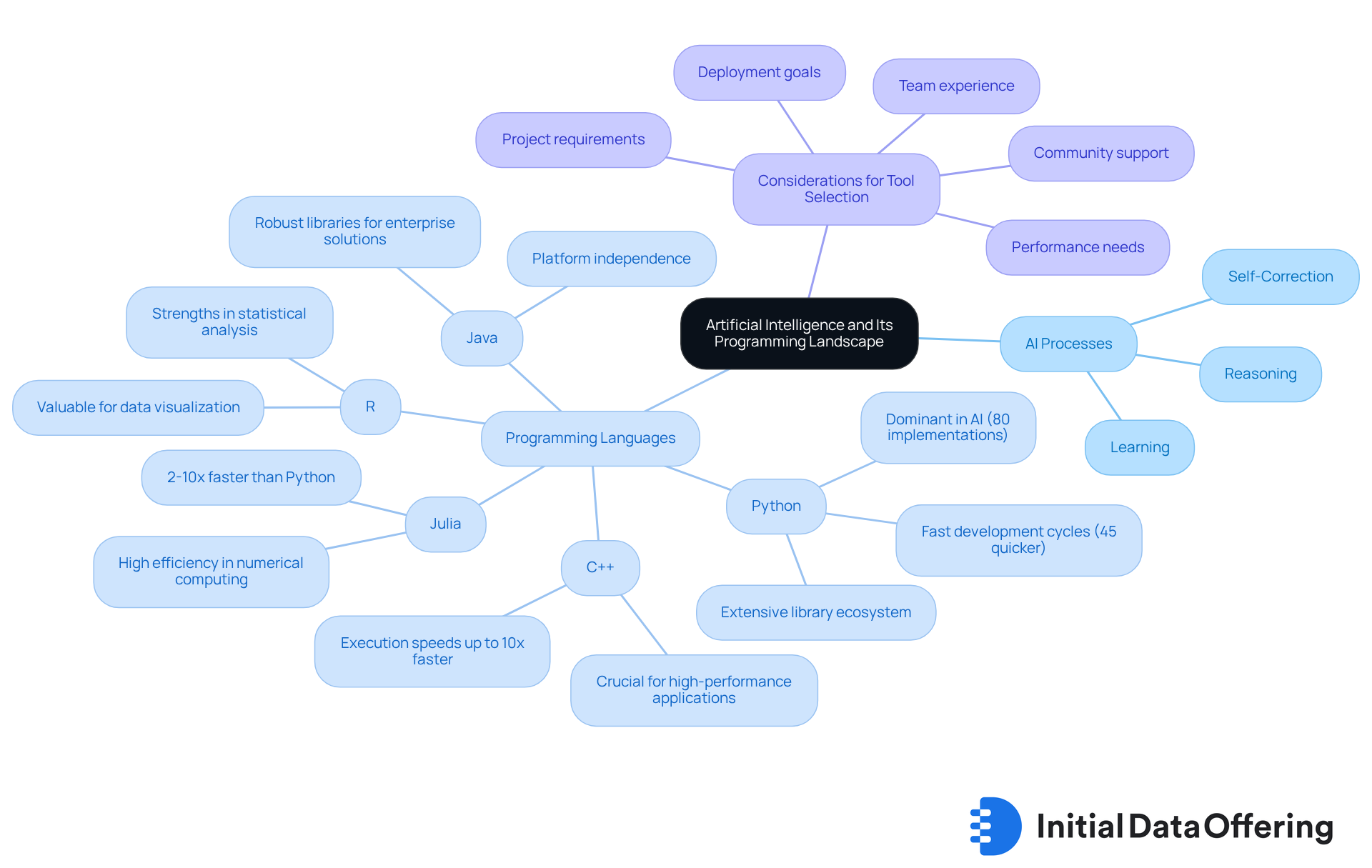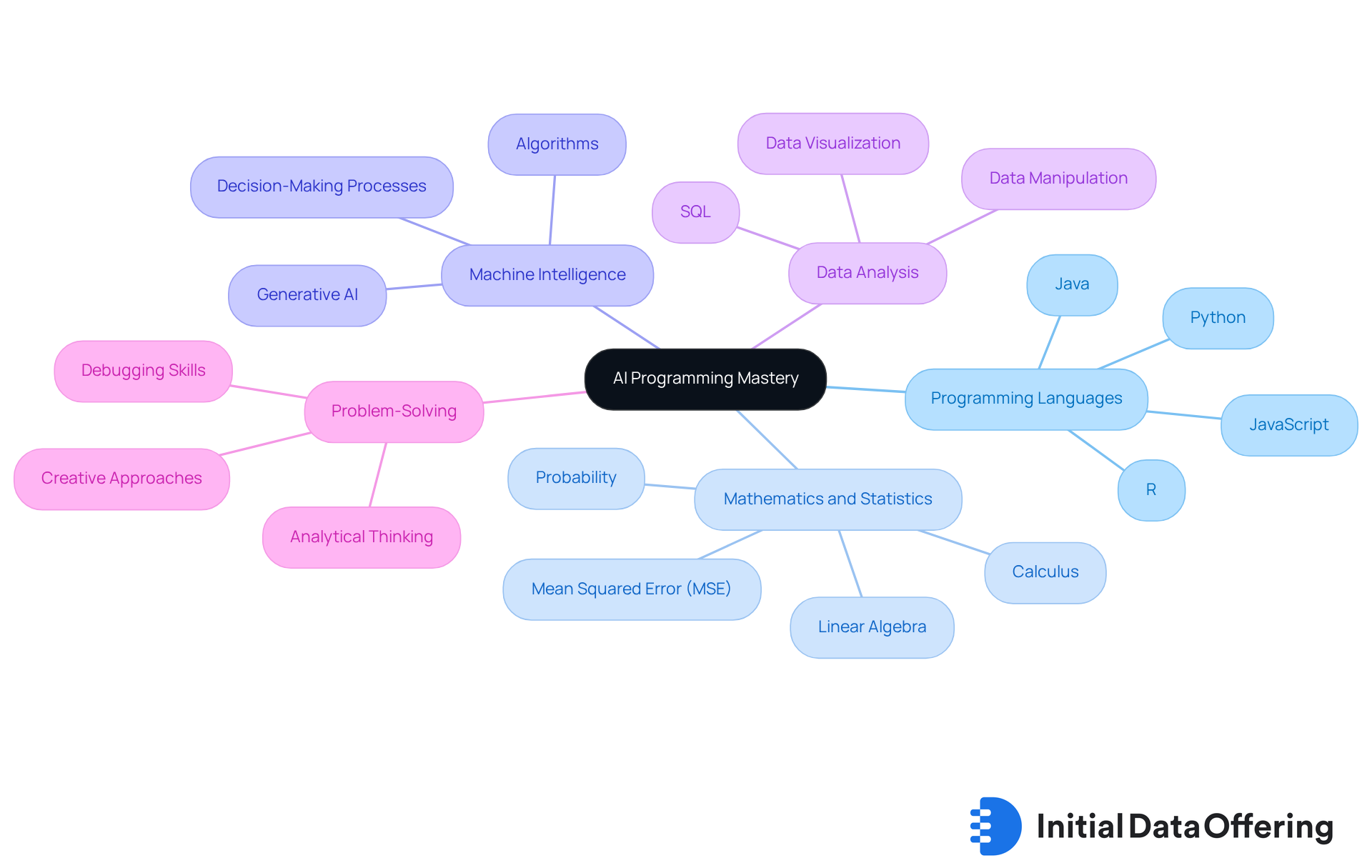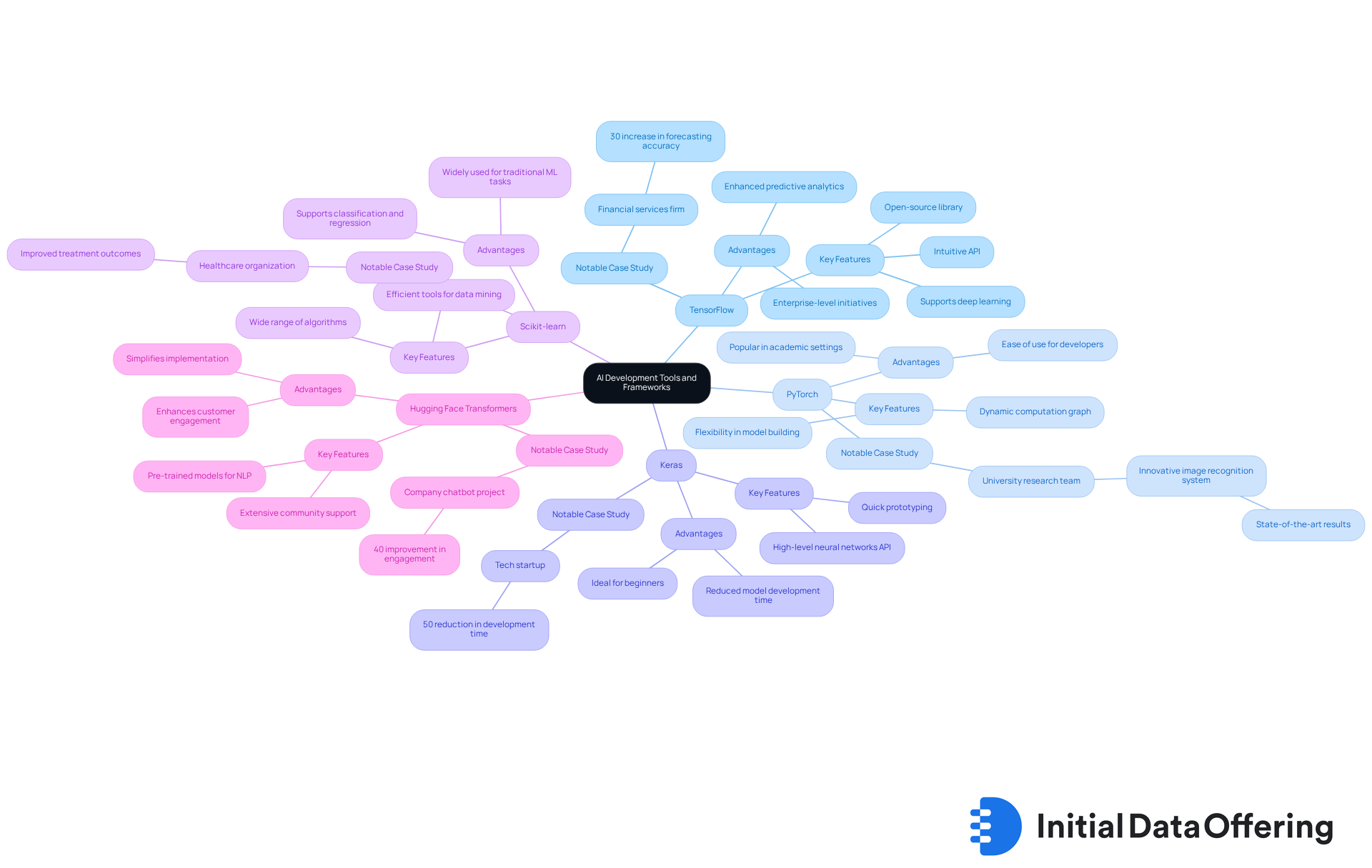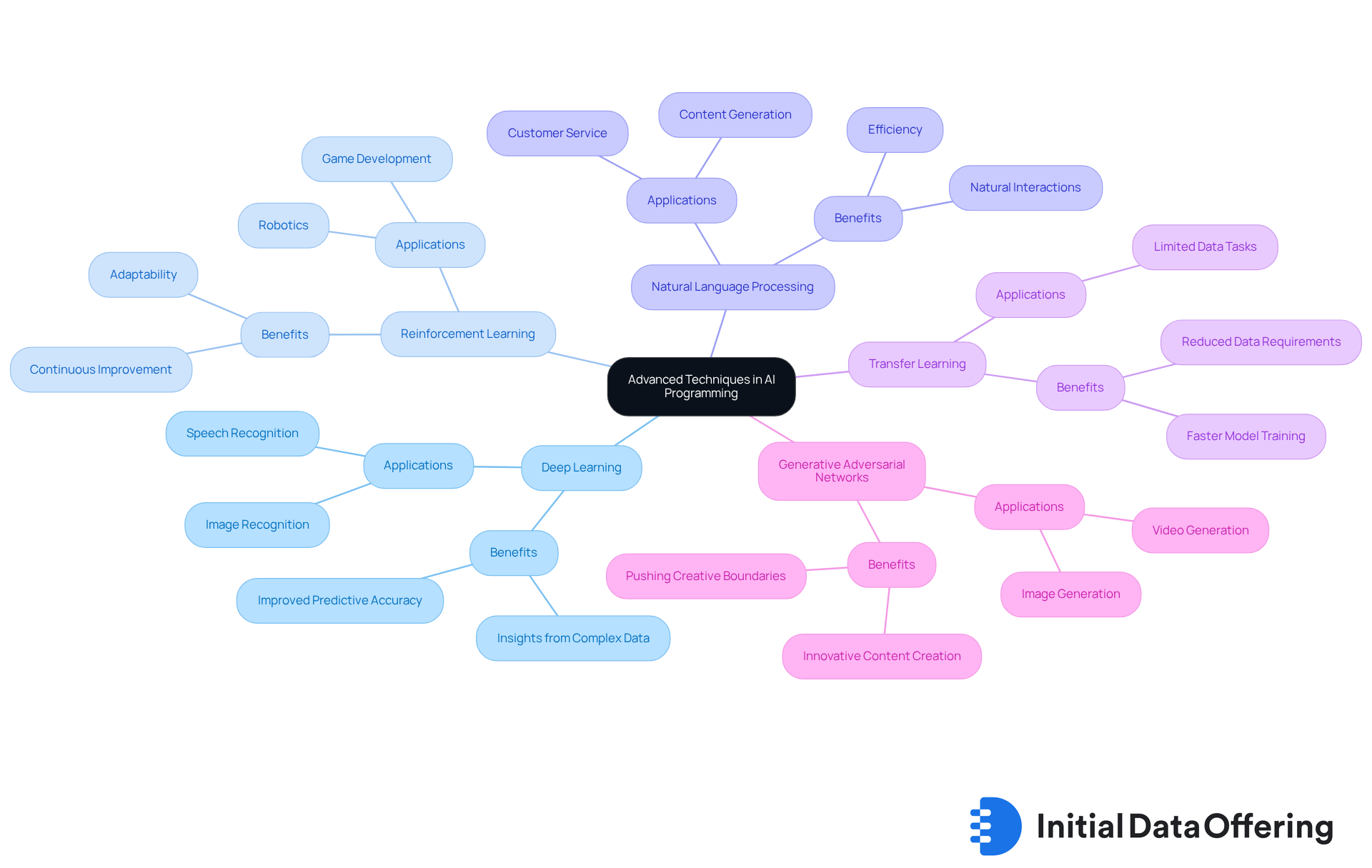Master AI Programming: Skills, Tools, and Techniques for Analysts

Master AI Programming: Skills, Tools, and Techniques for Analysts
Overview
The article focuses on the essential skills, tools, and techniques necessary for mastering AI programming. Key features include:
- Proficiency in programming languages such as Python and R
- A solid foundation in mathematics and statistics
- Familiarity with important frameworks like TensorFlow and PyTorch
These skills provide significant advantages, as they are critical for successfully developing and implementing AI projects. By honing these competencies, individuals can enhance their ability to navigate the complexities of AI programming, ultimately leading to more effective project outcomes.
How can these skills impact your approach to AI development?
Introduction
Artificial Intelligence (AI) is reshaping industries by mimicking human intelligence through advanced programming techniques. This evolution highlights the importance of understanding the right skills, tools, and frameworks for analysts aiming to excel in this dynamic field.
With a staggering 70% of AI projects failing due to poor tool selection, one must consider: how can professionals navigate this complex environment to ensure success in AI programming? By addressing these challenges, analysts can better position themselves to leverage AI's potential effectively.
Define Artificial Intelligence and Its Programming Landscape
Artificial Intelligence (AI) involves the simulation of human intelligence processes by machines, particularly computer systems. These processes encompass:
- Learning, which is the acquisition of information and rules for using it.
- Reasoning, which involves using rules to reach approximate or definite conclusions.
- Self-correction.
As of 2025, the AI programming environment includes a variety of coding systems and frameworks, each tailored for specific tasks. Notably, Python remains the dominant choice, powering approximately 80% of AI agent implementations. Its simplicity and extensive library ecosystem make it particularly favored, enabling swift prototyping and integration. This versatility leads to development cycles that are 45% quicker than those of conventional programming systems.
R is recognized for its strengths in statistical analysis and data visualization, making it an invaluable tool for data-driven AI projects, especially in academic settings. Java continues to play a significant role in enterprise-level solutions due to its platform independence and robust libraries, which enhance scalability and maintainability. These features position Java as a reliable option for large-scale applications.
Emerging systems like Julia are gaining traction for their high efficiency in numerical computing, achieving speeds 2-10 times quicker than Python. This efficiency renders Julia particularly suitable for computationally demanding tasks. Additionally, C++ is crucial for high-performance applications, especially in robotics and real-time systems, providing execution speeds that can be up to 10 times faster than interpreted systems.
Understanding these distinctions is essential for for projects in AI programming. As the AI landscape continues to evolve, the choice of AI programming tool can significantly influence project success, affecting factors such as development speed, system performance, and maintenance costs. Importantly, 70% of AI projects fail due to inadequate wording choices, underscoring the significance of informed decision-making in this field.
How can you ensure that your tool selection aligns with your project goals?

Identify Key Skills for AI Programming Mastery
To master the field of AI programming, one must develop a diverse skill set that encompasses several critical areas.
- Programming Languages: Proficiency in languages such as Python, R, and Java is essential. These languages are not only widely used in the industry but also provide the flexibility needed to tackle various AI challenges. By mastering these languages, individuals can enhance their coding efficiency and adaptability in different projects.
- Mathematics and Statistics: A solid understanding of linear algebra, calculus, and probability is crucial for developing algorithms. This mathematical foundation enables programmers to create models that can learn from data, making it a vital component of AI success. How well do you understand these mathematical principles, and how could they impact your AI projects?
- Machine Intelligence: Familiarity with machine intelligence concepts and algorithms is necessary for creating intelligent systems. Understanding these concepts allows programmers to design systems that can , thereby improving automation and efficiency.
- Data Analysis: Skills in data manipulation and analysis are vital for extracting insights from datasets. The ability to analyze data effectively can lead to more informed decision-making and innovative solutions in AI applications. Consider how enhancing your data analysis skills could benefit your current projects.
- Problem-Solving: The ability to approach complex problems creatively and analytically is crucial in AI advancement. This skill not only fosters innovation but also equips programmers to overcome the challenges that arise in developing AI systems. Reflect on the problem-solving strategies you currently employ—how might they evolve as you deepen your expertise in AI programming?

Explore Essential Tools and Frameworks for AI Development
Several tools and frameworks play a pivotal role in AI development, each offering distinct features, advantages, and benefits:
- TensorFlow: This open-source library for numerical computation accelerates machine learning processes. In 2025, TensorFlow remains a fundamental element for enterprise-level initiatives, particularly in deep analysis applications. Its intuitive API enables swift project development. For instance, a recent case study highlighted how a financial services firm utilized TensorFlow to enhance its predictive analytics capabilities, resulting in a 30% increase in forecasting accuracy.
- PyTorch: Known for its flexibility, this deep learning framework is favored in both research and production settings. Its dynamic computation graph allows for intuitive structure creation, making it a preferred choice among developers. In 2025, PyTorch continues to lead in popularity, especially in academic environments, due to its ease of use and adaptability. A notable example features a university research team that leveraged PyTorch to create an innovative image recognition system, achieving state-of-the-art results in benchmark tests.
- Keras: Operating atop TensorFlow, Keras is a high-level neural networks API that streamlines the construction of deep algorithms. It is particularly beneficial for beginners, enabling quick prototyping and experimentation. A tech startup recently reported that using Keras reduced their model development time by 50%, allowing them to bring their product to market faster.
- Scikit-learn: This library for machine intelligence in Python offers simple and efficient tools for data mining and analysis. It is widely used for traditional machine learning tasks, providing a range of algorithms for classification, regression, and clustering. A case study demonstrated how a healthcare organization utilized Scikit-learn to analyze patient data, leading to improved treatment outcomes.
- Hugging Face Transformers: This library offers pre-trained systems for natural text processing tasks, simplifying the implementation of state-of-the-art systems. Its extensive community support and resources enhance accessibility for developers. A recent project showcased how a company integrated Hugging Face Transformers to develop a chatbot that improved customer engagement by 40%.
In 2025, approximately 84% of developers are utilizing AI tools like TensorFlow and PyTorch, reflecting their effectiveness in enhancing productivity and streamlining workflows. The recent progress in these frameworks features better support for extensive language systems and increased interoperability, ensuring they remain at the forefront of AI innovation. As noted by industry experts, the choice of the right framework is crucial for building scalable and efficient AI solutions, with TensorFlow and PyTorch leading the way in this rapidly evolving landscape.

Implement Advanced Techniques in AI Programming
To implement advanced techniques in AI programming, consider several effective approaches that can improve your projects.
AI programming in Deep Learning involves utilizing neural networks with multiple layers to model complex patterns within large datasets. This technique allows for the identification of intricate relationships in data, leading to improved predictive accuracy and insights. As a result, it is particularly beneficial for tasks such as image and speech recognition.
AI programming in Reinforcement Learning focuses on algorithms that learn optimal actions through trial and error. This method is often applied in robotics and game development, where agents learn to navigate environments or make decisions based on feedback. The advantage here is the ability to develop systems that can adapt and improve over time, which is crucial for dynamic applications.
AI programming in Natural Language Processing (NLP) employs techniques that enable machines to comprehend and react to human language. By utilizing frameworks such as BERT and GPT, NLP facilitates more natural interactions between humans and machines. This capability is increasingly important in customer service and content generation, providing significant benefits in efficiency and user experience.
Transfer Learning in AI programming leverages to enhance performance on specific tasks with limited data. This approach reduces the need for extensive datasets, making it accessible for projects with resource constraints. Consequently, it allows practitioners to achieve high accuracy more quickly and with less computational expense.
AI programming using Generative Adversarial Networks (GANs) serves as a powerful tool for generating new data samples that closely resemble existing data. This technique is particularly useful in image and video generation, offering innovative solutions in creative fields. By exploring GANs, developers can push the boundaries of what is possible in content creation, leading to exciting advancements in various industries.

Conclusion
Mastering AI programming is not merely about understanding code; it encompasses a comprehensive grasp of the tools, techniques, and skills that drive this dynamic field. The programming landscape of AI in 2025 is characterized by the dominance of languages like Python, R, and Java, each serving distinct purposes and offering unique advantages. Navigating this landscape effectively is crucial for anyone aspiring to excel in AI development.
Key skills such as:
- Proficiency in programming languages
- A solid foundation in mathematics and statistics
- An understanding of machine intelligence concepts
are vital for successful AI programming. Familiarity with essential tools and frameworks like TensorFlow, PyTorch, and Keras can significantly enhance the efficiency and effectiveness of AI projects. The exploration of advanced techniques such as deep learning, reinforcement learning, and natural language processing illustrates the depth of knowledge required to innovate and excel in this arena.
As the AI programming landscape continues to evolve, the importance of informed decision-making in tool selection and skill development cannot be overstated. Embracing a diverse skill set and leveraging cutting-edge techniques will empower developers to create impactful AI solutions that address complex challenges. The future of AI programming is bright, and those who commit to mastering these elements will undoubtedly lead the charge in shaping its trajectory.
Frequently Asked Questions
What is Artificial Intelligence (AI)?
Artificial Intelligence (AI) involves the simulation of human intelligence processes by machines, particularly computer systems. These processes include learning, reasoning, and self-correction.
What are the key processes involved in AI?
The key processes involved in AI are learning (acquisition of information and rules), reasoning (using rules to reach conclusions), and self-correction.
What programming languages are commonly used in AI development?
Common programming languages used in AI development include Python, R, Java, Julia, and C++.
Why is Python favored in AI programming?
Python is favored in AI programming because it powers approximately 80% of AI agent implementations, offering simplicity, an extensive library ecosystem, and enabling faster prototyping and integration.
What advantages does R provide for AI projects?
R is recognized for its strengths in statistical analysis and data visualization, making it especially valuable for data-driven AI projects, particularly in academic settings.
How does Java contribute to AI development?
Java plays a significant role in enterprise-level solutions due to its platform independence and robust libraries, which enhance scalability and maintainability for large-scale applications.
What is the emerging role of Julia in AI programming?
Julia is gaining traction for its high efficiency in numerical computing, achieving speeds 2-10 times quicker than Python, making it suitable for computationally demanding tasks.
What is the significance of C++ in AI applications?
C++ is crucial for high-performance applications, particularly in robotics and real-time systems, providing execution speeds that can be up to 10 times faster than interpreted systems.
Why is tool selection important in AI programming?
Tool selection is essential in AI programming because it can significantly influence project success, affecting development speed, system performance, and maintenance costs.
What is a major reason for the failure of AI projects?
A major reason for the failure of AI projects is inadequate wording choices, with 70% of projects failing due to this issue, highlighting the importance of informed decision-making in selecting tools.